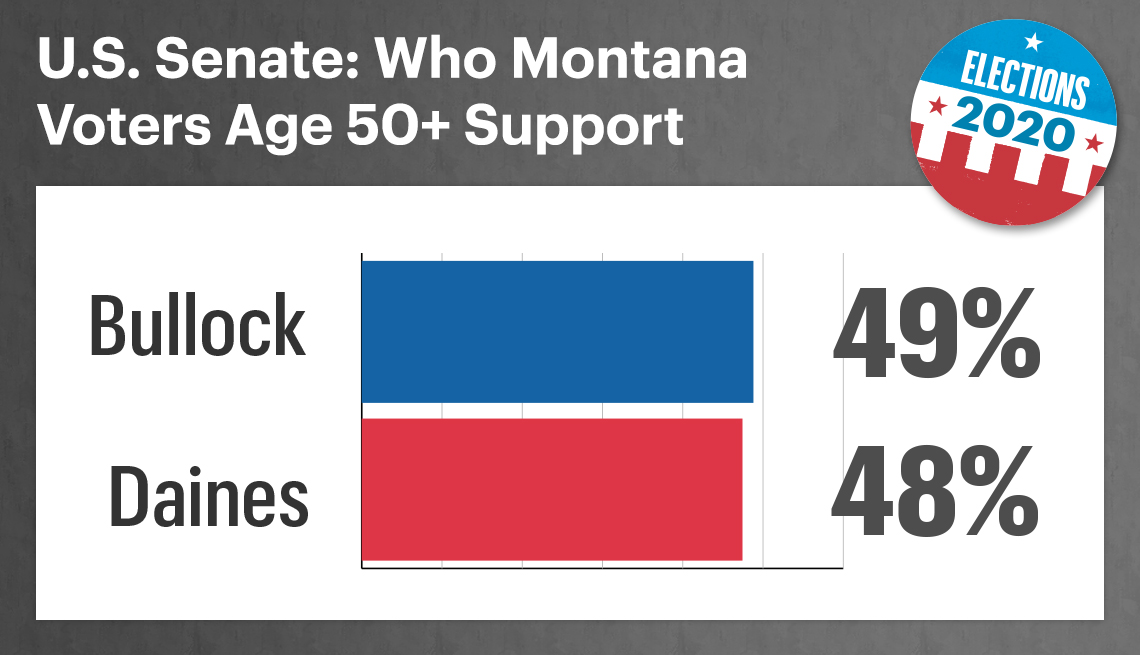AARP Hearing Center

Jobs and the economy is the most important issue for Montana voters age 50 and older when deciding which U.S. Senate candidate to support, followed by Social Security and health care, according to a new AARP poll that shows older Americans could decide the 2020 elections.
The full results of the AARP poll, released Tuesday, show that 60 percent of voters 50-plus believe the country is on the wrong track, while 33 percent say it is moving in the right direction.
Eighty-four percent say jobs and the economy and Social Security are their top issues, followied by 79 percent who cite health care. Older voters worry most about prices rising faster than their incomes (57 percent), having health expenses they can’t afford (54 percent) and having to pay too much in taxes (58 percent).
Montana voters 50-plus are more likely to vote for a candidate who supports protecting Medicare from cuts and ensuring America’s seniors get the health care they need (93 percent), allowing Medicare to negotiate with drug companies for lower prices (89 percent) and protecting Social Security from cuts (86 percent).
These results show that, despite the strong partisan divisions in the county, “there are some foundational programs that cut across these divisions — notably Social Security and Medicare,” says John Hishta, AARP senior vice president for campaigns. “These are areas that 50-plus voters care deeply about, no matter where they stand. And it shows that the candidates should be addressing those issues with these voters.”
Other key findings of the poll:
- Montana voters 50-plus are more likely to vote for a candidate who supports protecting Medicare from cuts and ensuring America’s seniors get the health care they need (85 percent), allowing Medicare to negotiate with drug companies for lower prices (87 percent) and protecting Social Security from benefit cuts (85 percent).
- A majority are more likely to vote for a candidate who is focused on maintaining law and order and preventing looting and rioting in America’s cities (53 percent) than one who is focused on increasing racial justice and reducing police violence against unarmed African Americans (37 percent).
- Voters are split over whether they are concerned (50 percent) that an expansion of mail-in ballots will lead to voter fraud compared with those who are not concerned (49 percent).
- More Montana voters 50-plus are likely to vote for a candidate who is focused on rebuilding the economy by reopening businesses and getting people back to work (49 percent) than those who want a candidate focused on keeping families healthy and reducing the spread of coronavirus in their community (45 percent).
- Forty-six percent say they or someone in their household know someone who has contracted the coronavirus.
Earlier results from the poll, released last week, show Montana’s U.S. Senate race is a statistical dead heat among likely voters age 50-plus. Incumbent Sen. Steve Daines, a Republican, trails Gov. Steve Bullock, a Democrat, 48 percent to 49 percent among those older voters polled. The survey also reveals that 65 percent of older Montanans plan to cast absentee or mail-in ballots. Among all Big Sky Country voters, Daines leads Bullock 50 percent to 47 percent in the U.S. Senate race. Daines, 58, is seeking a second six-year term while Bullock, 54, who was a presidential primary contender, has been governor since 2012 and term limits prevented him from running for another term.
In the presidential race, President Donald Trump and Vice President Joe Biden are virtually tied (Trump 48 percent to Biden 47 percent) among 50-plus voters, while Trump holds a seven-point lead over Biden (50 percent to 43 percent) among all Montana voters.
The survey found that Montana’s voters age 50-plus are worried about their votes being counted. A 61 percent majority said they were very or somewhat concerned and 38 percent said they were not concerned that reductions in the U.S. Postal Service are going to prevent votes from being counted in November. Among Montana respondents 24 percent said they planned to vote in person on Election Day, and 8 percent said they planned to cast their ballot in person – but during the early voting period.
AARP’s Protect Voters 50+ campaign is designed to help make sure that even as America continues to deal with the coronavirus crisis, that all voters get the information they need to safely cast a ballot. “One thing we know is that virtually all older voters plan to vote this year,” said Nancy LeaMond, AARP executive vice president and chief advocacy and engagement officer. “They want to vote, they want their voices heard and they’re going to find a way to do that that’s safe,” she said. AARP is working in every state to educate older voters on what their voting options are.
“We believe 50-plus voters are going to play a critical role in this year’s election,” LeaMond said. She pointed out that while Americans age 50 and older comprise 45 percent of the voting population, they accounted for 56 percent of the ballots cast in 2016. “They punch above their weight,” LeaMond added.
AARP commissioned the bipartisan polling team of Fabrizio Ward & Hart Research to conduct polls in five states with key U.S. Senate races, including Montana. The firms interviewed 1,200 likely Montana voters, which includes a statewide representative sample of 800 likely voters, with an oversample of 400 likely voters age 50 and older, between Aug. 30 and Sept. 5. The interviews were conducted via landline and cellphone. The margin of sampling error for the 800 statewide sample is plus or minus 3.5 percent; for the 837 total sample of voters 50+ is plus or minus 3.4 percent.
Also of Interest
































































